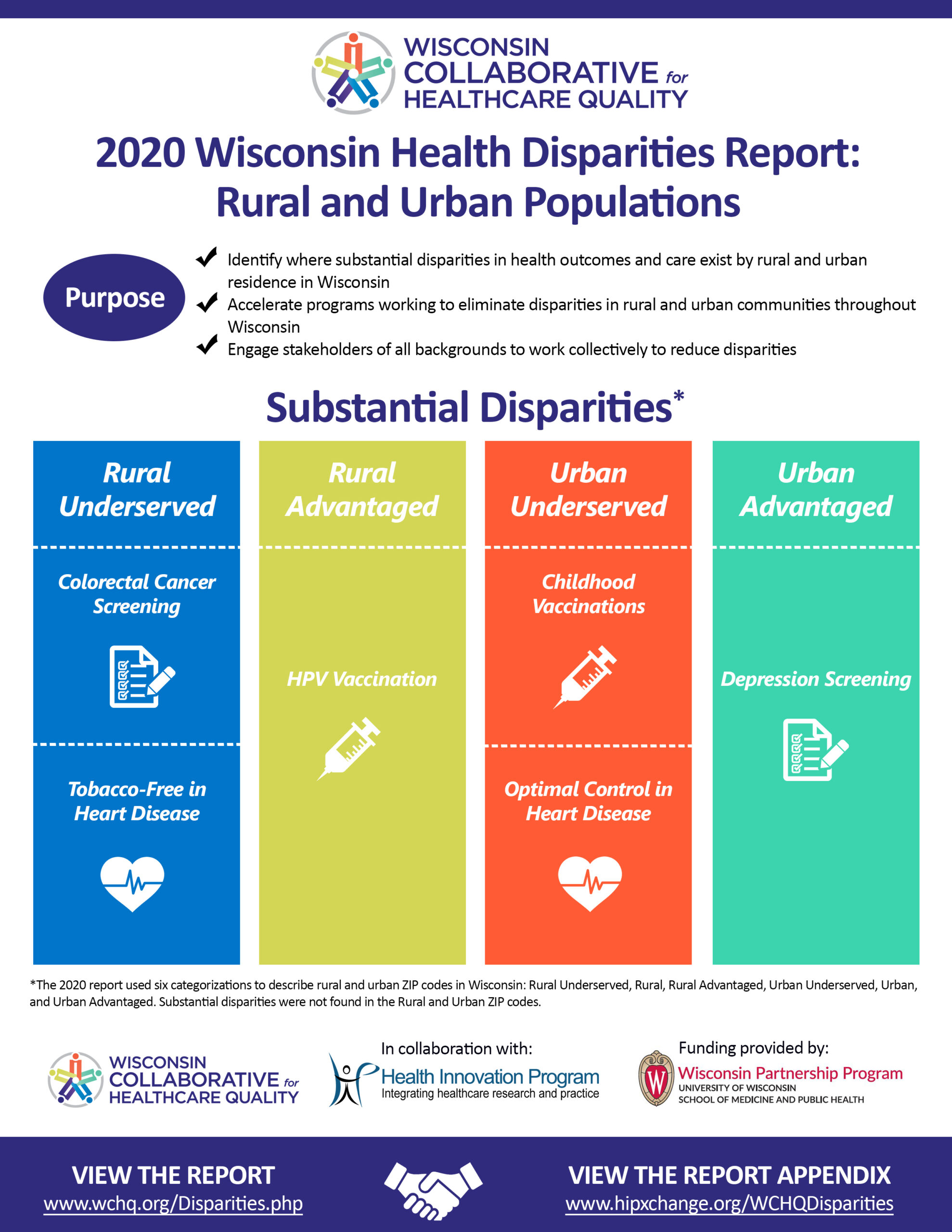- Cancer
- Children and Young Adults
- Chronic Conditions
- Datasets and Research Tools
- Dissemination and Implementation
- Health Equity
- Mental Health
- Older Adults
- Prevention
- Quality and Safety
*Free registration is required to use the toolkits provided within HIPxChange. This information is required by our funders and is used to determine the impact of the materials posted on the website.
 WCHQ Disparities Reports Overview
WCHQ Disparities Reports Overview
Widespread disparities exist in health outcomes and care in Wisconsin. Although Wisconsin ranks high in overall health care nationally, the state performs poorly with respect to disparities.
The Wisconsin Collaborative for Healthcare Quality (WCHQ), in collaboration with the University of Wisconsin Health Innovation Program, developed the 2019 Wisconsin Health Disparities Report and the 2020 Wisconsin Health Disparities Report: Rural and Urban Populations to identify where disparities in health outcomes and care exist in Wisconsin and to help inform and accelerate programs that are working to eliminate disparities. Through identifying and publicly reporting these differences, these reports will draw attention to and promote public accountability, improvement, and action by multiple stakeholders.
Eliminating health disparities is a task that cannot be done by health systems alone or accomplished in silos. This report can contribute to the identification of opportunities for health systems, health departments, policymakers, nonprofits and employers to develop collaborative approaches within their communities to create a healthier Wisconsin for all.
To view the WCHQ 2020 Wisconsin Health Disparities Report: Rural and Urban Populations, click here.
To view the WCHQ 2019 Wisconsin Health Disparities Report, click here.
The 2020 Infographic contains the concluding results of the WCHQ 2020 Wisconsin Health Disparities Report: Rural and Urban Populations. To view the 2020 Infographic, click here.
The 2019 Infographic contains the concluding results of the WCHQ 2019 Wisconsin Health Disparities Report. To view the 2019 Infographic, click here.
Report Citations
2020 Report
Wisconsin Collaborative for Healthcare Quality and the University of Wisconsin Health Innovation Program. Wisconsin Health Disparities Report: Rural and Urban Populations, 2020.
2019 Report
Wisconsin Collaborative for Healthcare Quality and the University of Wisconsin Health Innovation Program. Wisconsin Health Disparities Report, 2019, Appendix.
Appendix Overview
The 2020 Appendix contains detailed methodology, measure definitions for all WCHQ measures, and tables including performance and denominator data for all measures stratified by the new and distinct rural and urban groupings.
The 2019 Appendix contains detailed methodology, measure definitions for all WCHQ measures, and tables including performance and denominator data for all measures stratified by race/ethnicity, payer and rural/urban residence.
To read each of the report Appendices, click View 2019 Appendix or View 2020 Appendix at the top of the page
*Free registration is required to view the Report Appendices. This information is required by our funders and is used to determine the impact of the materials posted on the website.
Appendix Citations
2020 Report Appendix
Wisconsin Collaborative for Healthcare Quality and the University of Wisconsin Health Innovation Program. Wisconsin Health Disparities Report: Rural and Urban Populations, 2020, Appendix.
2019 Report Appendix
Wisconsin Collaborative for Healthcare Quality and the University of Wisconsin Health Innovation Program. Wisconsin Health Disparities Report, 2019, Appendix.
2020 WCHQ Health Disparities Assembly
The 2020 Wisconsin Health Disparities Report: Rural and Urban Populations was released at the WCHQ Health Disparities Assembly meeting on November 12, 2020. Jennifer Weiss, MD, MS and Matt Gigot, MPH, presented the findings from the 2020 report. Both contributed to the research and analysis conducted to document health disparities in Wisconsin related to geography. Dr. Weiss is a HIP Investigator and associate professor in the division of gastroenterology and hepatology at the University of Wisconsin School of Medicine and Public Health. Gigot is the director of performance measurement and analysis at WCHQ.
View Jennifer Weiss and Matt Gigot’s presentation here.
The assembly featured urban and rural perspectives on health disparities from experts in their fields. Malia Jones, PhD, MPH, is an expert in social factors related to infectious disease, demography, and geospatial research methods. Dr. Jones presented her research on social and spatial determinants of health at the population level.
View Malia Jones’ presentation here.
Funding Organization
Wisconsin Partnership Program
The Wisconsin Partnership Program (WPP) was established at the UW-Madison School of Medicine and Public Health in 2004 through a generous and visionary endowment gift from Blue Cross and Blue Shield United of Wisconsin’s conversion to a stock insurance corporation. Its mission is to improve the public health needs of Wisconsin and reduce health disparities through initiatives in research, education and community partnerships. The 2019 and 2020 Wisconsin Health Disparities Reports were funded by WPP through a grant to HIP and WCHQ.




